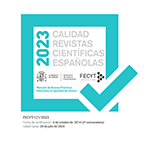El objeto de diseño como paradigma fílmico: Una revisión a los principios creativos de La naranja mecánica
Resumen
El primer “pliegue” argumental que se produce en el metraje de La naranja mecánica (1971) coincide con el final de la secuencia que transcurre en la residencia de la Sra. Weathers. Concatenadas por una sucesión de fechorías a cargo de los Drugos, cada una de esas escenas se construye sobre un dominio visual en el que Kubrick, deliberadamente, “aísla al espectador [obligándolo] a establecer la conexión narrativa solo a través de la imagen” (Walker, 1975, p. 257). Una imagen que suscribe el valor del objeto de diseño desde su identidad gráfica, industrial y urbanística, para confortar la escenografía y la relevancia del relato. Metodológicamente, el patrimonio objetual de 2001: Una odisea del espacio (1968) se convierte aquí en un catalizador iconográfico de la narrativa visual que Kubrick aplicaría posteriormente sobre la “epidermis” de La naranja mecánica. Asimismo, el objeto de diseño, en su condición material o abstracta, alcanza en el presente estudio un protagonismo que se cuantifica en los impactos visuales registrados temporalmente en las escenas del fragmento intervenido. En suma, un análisis de contenido en torno al objeto como constructo fílmico, que evidencia —como resultado— la fascinación de Kubrick por el diseño en cualquiera de sus órdenes.
Descargas
Descarga artículo
Licencia
La revista Arte, Individuo y Sociedad, para fomentar el intercambio global del conocimiento, facilita el acceso sin restricciones a sus contenidos desde el momento de su publicación en la presente edición electrónica, y por eso es una revista de acceso abierto. Los originales publicados en esta revista son propiedad de la Universidad Complutense de Madrid y es obligatorio citar su procedencia en cualquier reproducción total o parcial. Todos los contenidos se distribuyen bajo una licencia de uso y distribución Creative Commons Reconocimiento 4.0 (CC BY 4.0). Esta circunstancia ha de hacerse constar expresamente de esta forma cuando sea necesario. Puede consultar la versión informativa y el texto legal de la licencia.










